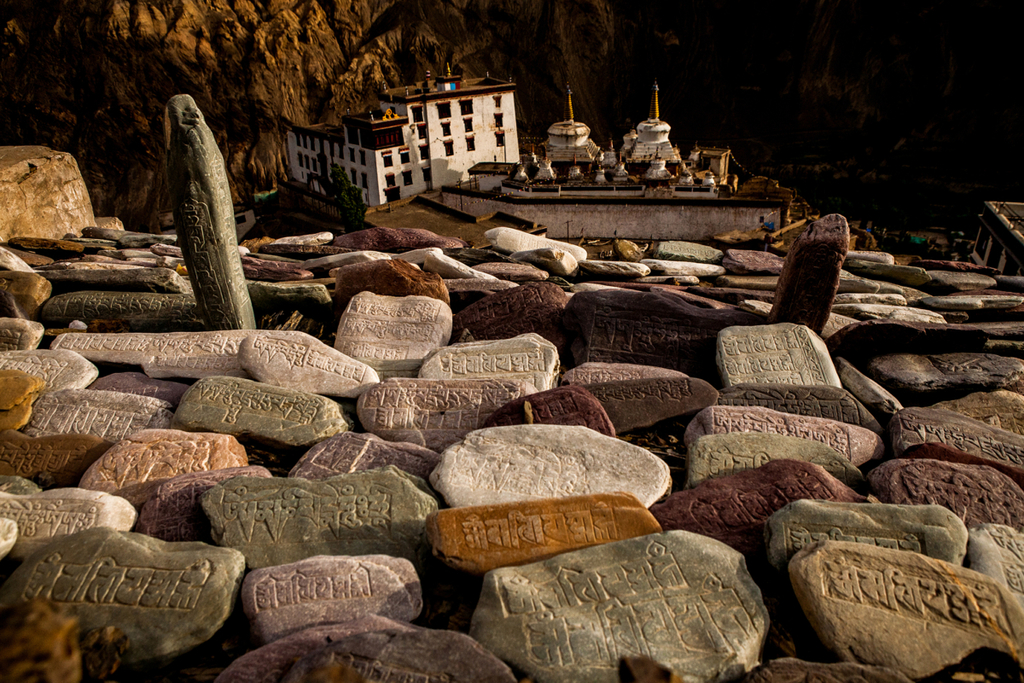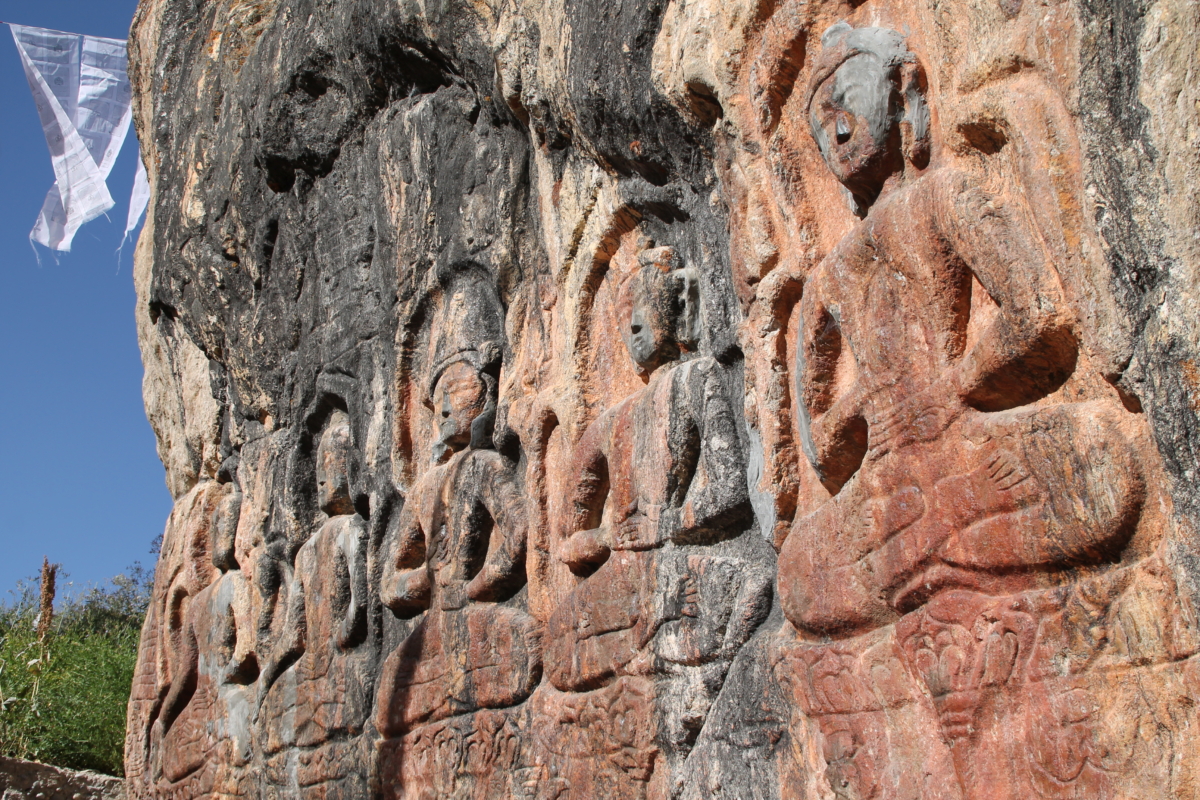Ladakh, with its breathtaking landscapes of barren mountains, deep blue skies, and vibrant cultures, holds within its rugged terrain an ancient and often overlooked treasure—petroglyphs. These rock carvings, etched into the dark, weathered surfaces of stones scattered across this high-altitude desert, are more than mere remnants of a bygone era. They are silent storytellers, offering glimpses into the lives, beliefs, and artistic expressions of the people who once roamed these lands thousands of years ago.
A Vast Open-Air Museum
Ladakh’s petroglyphs are spread across the region, particularly along the riverine stretches of the Indus River, which winds its way through this majestic land. These ancient carvings are found in some of the most remote and inhospitable areas, from the Nubra Valley to the outskirts of Leh, the region’s capital. Each site is like an open-air museum, where the rocks themselves serve as the canvas for a rich tapestry of human and animal figures, abstract symbols, and mysterious handprints.
Key Petroglyph Sites in Ladakh
Kawathang
What to See: Located about 100 km from Leh, Kawathang is home to some of the most intriguing petroglyphs in Ladakh. The site features delicate hand impressions with elongated fingers, hunting scenes, and abstract symbols. These carvings are a window into the spiritual and social life of ancient communities.
Domkhar
What to See: Domkhar is another significant site near Leh, known for its extensive collection of petroglyphs. Here, you can see carvings of ibexes, a common motif in Ladakh’s rock art, as well as scenes depicting human figures in various postures, possibly indicating ritualistic dances or hunting practices.
Alchi
What to See: Alchi is famous for its ancient monastery, but it also hosts petroglyphs that are often overlooked by visitors. These carvings include detailed representations of animals, such as wild goats and yaks, and symbolic motifs that are believed to have spiritual significance.
Tangtse
What to See: Located in the Changthang region, Tangtse is known for its remote and rugged landscapes. The petroglyphs here include geometric patterns and abstract designs, offering insights into the early artistic expressions of the region’s inhabitants.
Nubra Valley (Skindisa)
What to See: Skindisa, a site within the Nubra Valley, is home to a striking piece of rock art referred to as the “Stone Temple.” This site features a large, intricate carving that stands out against the desolate backdrop of the valley. The petroglyphs here include images of ibexes, hunting scenes, and possibly depictions of ancient rituals.

These ancient petroglyphs, found on the path to Meditation Hill in Lamayuru, Ladakh, feature Tibetan script meticulously carved into stones that mirror the vibrant colors of Ladakh’s mountains, blending art with the natural landscape.Khaltse
What to See: Situated on the route to Lamayuru, Khaltse is another site rich in petroglyphs. The carvings here are diverse, featuring animals, human figures, and abstract symbols. This site is particularly important for understanding the link between Ladakh’s rock art and the broader cultural exchanges along the ancient trade routes.
Saspochey
What to See: Located near Alchi, Saspochey has a variety of petroglyphs that include depictions of ibexes, camels, and other animals, as well as scenes that might represent daily life or ceremonial events. The site is also noted for its detailed human figures.
Shey
What to See: Near the famous Shey Monastery, the petroglyphs here are more symbolic, with geometric patterns and abstract designs that may have had ritualistic or spiritual purposes. The carvings at Shey provide a contrast to the more representational art found at other sites.
The Artistry of Survival
What is striking about these rock carvings is their simplicity and sophistication. The images, often rendered in the most basic forms, exhibit a deep understanding of the subjects they depict. Ibexes, with their gracefully curved horns, are among the most common motifs, symbolizing not just the presence of this wild goat in the region but also its importance in the lives of the people as a source of sustenance and spiritual significance.
Hunting scenes, rites of passage, communal dances, and abstract symbols populate the rocky canvases, each telling a story of survival, celebration, and spirituality. The artists who created these petroglyphs were not only skilled in their craft but also deeply connected to their environment, using the natural contours of the rocks to enhance their compositions. The enduring quality of these images is a testament to the resilience of the human spirit and its ability to create beauty even in the harshest conditions.
The Fragility of a Timeless Legacy
Despite their durability, Ladakh’s petroglyphs are not immune to the ravages of time and human activity. Unlike cave art, which is often protected by the shelter of its environment, these open-air carvings are exposed to the elements—sun, wind, and water—as well as the growing encroachment of modern development. Road construction, tourism, and even graffiti pose significant threats to these ancient artworks, leading to the gradual disappearance of some of the most significant sites.
In recent years, efforts have been made to document and preserve these petroglyphs. Scholars, photographers, and conservationists have embarked on challenging journeys into the farthest corners of Ladakh to catalog these carvings before they are lost forever. Among them is Ahtushi Deshpande, whose decade-long quest to capture the beauty and significance of Ladakh’s rock art has resulted in a comprehensive documentation of over 200 sites across the region.
A Call for Preservation
The petroglyphs of Ladakh are not just historical artifacts; they are a vital link to our collective human heritage. They remind us of a time when humans lived in harmony with nature, and their art was a direct reflection of that relationship. As the modern world encroaches upon these ancient sites, it is crucial that steps are taken to protect and preserve them.
Initiatives such as community awareness programs, the creation of protected areas, and the development of sustainable tourism practices can help ensure that these ancient rock arts are preserved for future generations. Furthermore, the inclusion of Ladakh’s petroglyphs in the broader narrative of world heritage could provide the impetus needed for their protection at both national and international levels.
The ancient rock arts of Ladakh are more than just carvings on stone; they are windows into the soul of a people who have long since passed but whose legacy endures in the rugged beauty of their art. As we stand before these silent stones, we are reminded of the fragility of life, the resilience of the human spirit, and the timelessness of artistic expression. It is our responsibility to ensure that this legacy is preserved, not just as a testament to the past, but as a source of inspiration for the future.

